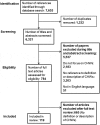Who is a community health worker? - a systematic review of definitions
- PMID: 28222653
- PMCID: PMC5328349
- DOI: 10.1080/16549716.2017.1272223
Who is a community health worker? - a systematic review of definitions
Abstract
Background: Community health workers (CHWs) can play vital roles in increasing coverage of basic health services. However, there is a need for a systematic categorisation of CHWs that will aid common understanding among policy makers, programme planners, and researchers.
Objective: To identify the common themes in the definitions and descriptions of CHWs that will aid delineation within this cadre and distinguish CHWs from other healthcare providers.
Design: A systematic review of peer-reviewed papers and grey literature.
Results: We identified 119 papers that provided definitions of CHWs in 25 countries across 7 regions. The review shows CHWs as paraprofessionals or lay individuals with an in-depth understanding of the community culture and language, have received standardised job-related training of a shorter duration than health professionals, and their primary goal is to provide culturally appropriate health services to the community. CHWs can be categorised into three groups by education and pre-service training. These are lay health workers (individuals with little or no formal education who undergo a few days to a few weeks of informal training), level 1 paraprofessionals (individuals with some form of secondary education and subsequent informal training), and level 2 paraprofessionals (individuals with some form of secondary education and subsequent formal training lasting a few months to more than a year). Lay health workers tend to provide basic health services as unpaid volunteers while level 1 paraprofessionals often receive an allowance and level 2 paraprofessionals tend to be salaried.
Conclusions: This review provides a categorisation of CHWs that may be useful for health policy formulation, programme planning, and research.
Keywords: Lay health worker; health workforce; role; scope of practice.
Figures
References
-
- World Health Organization and Global Health Workforce Alliance Synthesis paper of the thematic working groups - health work force 2030 - towards a global strategy on human resources for health. 2015
-
- World Health Organization Working together for health: the World Health Report 2006. 2006 - PubMed
-
- Global Health Workforce Alliance Global health workforce crisis key messages - 2013. 2013
-
- Lewin SA, Dick J, Pond P. Lay health workers in primary and community health care. [cited 2014 Dec 15;];Cochrane Database Syst Rev. 2005 1:CD004015. Jan. - PubMed
-
- Lehmann U, Sanders D. Community health workers: what do we know about them? The state of the evidence on programmes, activities, costs and impact on health outcomes of using community health workers. Geneva: World Health Organization; 2007. May 3, cited. 2014.
Publication types
MeSH terms
LinkOut - more resources
Full Text Sources
Other Literature Sources


